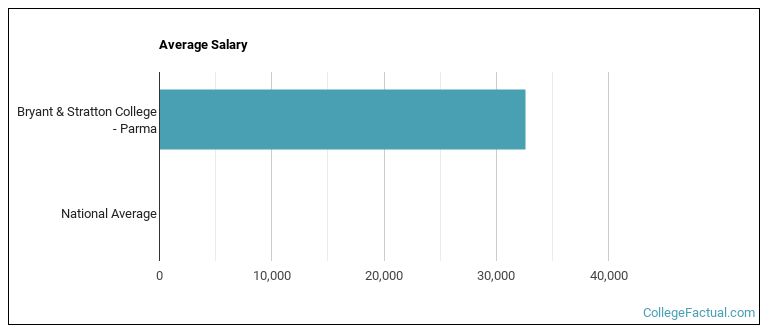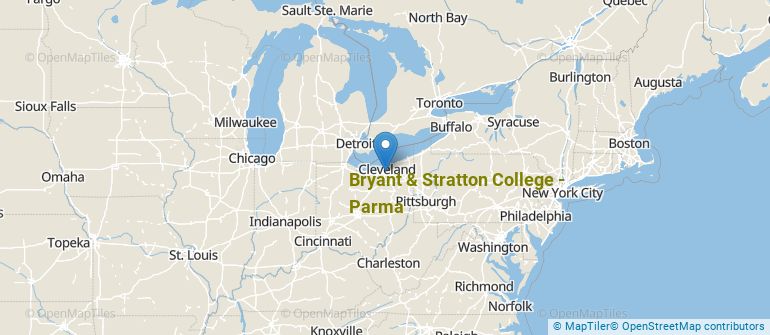 by our College Data Analytics Team
by our College Data Analytics TeamExplore the best ranked schools for the programs you are most interested in.
Bryant & Stratton College - Parma is ranked #1,041 out of 2,152 schools in the nation for overall quality on College Factual's 2025 Best Colleges list. This is an improvement over the previous year, when Bryant & Stratton College - Parma held the #2,017 spot on the Best Overall Colleges list.
Bryant & Stratton College - Parma is also ranked #37 out of 91 schools in Ohio.
See all of the rankings for Bryant & Stratton College - Parma.
Returning adults and other non-traditional students may appreciate the fact that Bryant & Stratton College - Parma has an open admissions policy. This means that you'll only have to submit basic materials, which may include proof that you completed high school or an equivalent program.
At Bryant & Stratton College - Parma, the student to faculty ratio is an excellent 11 to 1. That's much better than the national average of 15 to 1. This indicates that many classes will probably be small, and students will have ample opportunites to work closely with their professors and classmates.
In addition to the student to faculty ratio, some people look at what percentage of faculty members are full-time as a sign of how much time professors will be able to spend with their students. This is because part-time teachers may not be be on campus as much as their full-time counterparts.
The full-time faculty percentage at Bryant & Stratton College - Parma is 34%. This is lower than the national average of 47%.
During the 2017-2018 academic year, there were 765 undergraduates at Bryant & Stratton College - Parma with 539 being full-time and 226 being part-time.
| $0-30 K | $30K-48K | $48-75 | $75-110K | $110K + |
|---|---|---|---|---|
| $14,508 | $12,305 | $11,960 | $17,712 | $16,922 |
The net price is calculated by adding tuition, room, board and other costs and subtracting financial aid.Note that the net price is typically less than the published for a school. For more information on the sticker price of Bryant & Stratton College - Parma, see our tuition and fees and room and board pages.
Almost 66% of college students who graduated with the class of 2018 took out student loans, but that percentage varies from school to school. At Bryant & Stratton College - Parma, approximately 65% of students took out student loans averaging $5,096 a year. That adds up to $20,384 over four years for those students.
Get more details about paying for Bryant & Stratton College - Parma.

See which majors at Bryant & Stratton College - Parma make the most money.
Get more details about the location of Bryant & Stratton College - Parma.

Contact details for Bryant & Stratton College - Parma are given below.
| Contact Details | |
|---|---|
| Address: | 12955 Snow Rd, Parma, OH 44130-3151 |
| Phone: | 216-265-3151 |
| Website: | https://www.bryantstratton.edu/ |
| Most Popular Majors | Bachelor’s Degrees | Average Salary of Graduates |
|---|---|---|
| Nursing | 81 | $71,701 |
| Allied Health & Medical Assisting Services | 25 | NA |
| Public Health | 21 | $37,548 |
| Practical Nursing & Nursing Assistants | 20 | NA |
| General Business/Commerce | 18 | NA |
| Human Services | 9 | NA |
| Business Administration & Management | 4 | $36,375 |
| Accounting | 3 | NA |
| Information Technology | 2 | NA |
| Criminal Justice & Corrections | 2 | NA |
Online learning options are becoming more and more popular at American colleges and universities. Online classes are great for students who have busy schedules or for those who just want to study on their own time.
In 2022-2023, 310 students took at least one online class at Bryant & Stratton College - Parma. This is a decrease from the 350 students who took online classes the previous year.
| Year | Took at Least One Online Class | Took All Classes Online |
|---|---|---|
| 2022-2023 | 310 | 0 |
| 2021-2022 | 350 | 0 |
| 2020-2021 | 394 | 28 |
| 2018-2019 | 161 | 14 |
Learn more about online learning at Bryant & Stratton College - Parma.
Footnotes
*The racial-ethnic minorities count is calculated by taking the total number of students and subtracting white students, international students, and students whose race/ethnicity was unknown. This number is then divided by the total number of students at the school to obtain the racial-ethnic minorities percentage.
References
More about our data sources and methodologies.